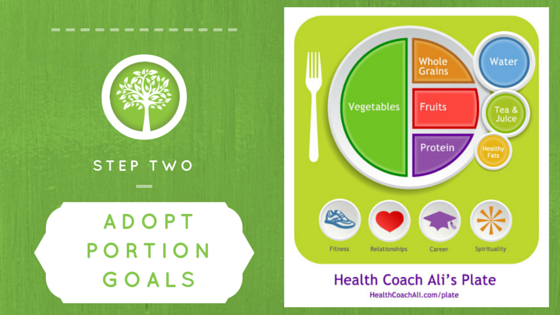
Determining portion goals for each meal throughout the day can be quite daunting and confusing. First of all, notice that I did not say portion CONTROLS. Instead, I said portion GOALS. Setting controls can be perceived as limiting you. Whereas, setting goals gives you something to aim for.
When I first started studying portion goals, there was a great deal of conflicting information out there. So much so that I didn’t know which plan to choose. And most of them included counting the grams I’m consuming in each food group, at each meal, all day long. Who wants to do that much math during the day?
So, I designed my own plan according to what fit best with the nutritionists I had studied. Then, I drew up a diagram (which was pretty sad in the way that it looked because I’m not a graphic designer). But eventually I came across the graphic pictured here by Health Coach Ali. It fits perfectly with my goals – and looks much better than the one I drew up for myself.
This plate helps me to eat a healthy balance of the 4 major food groups. To understand why this is necessary, it’s helpful to understand the 2 classifications of nutrients contained in these food groups:
1. Macro-nutrients: The large volume of nutrients contained in, or that make up a particular kind of food. These nutrients supply the body with calories needed for energy and help the body function. The 4 basic food groups: water, carbohydrates, protein and fats are classified according to their macro-nutrients. Macro-nutrients are measured in grams.
2. Micro-nutrients: The smaller nutrients in food which are just as crucial as the macro-nutrients and are needed for development, growth and maintaining a healthy immune system. They are usually counted in milligrams and include vitamins, minerals, and phyto(plant)nutrients which act as antioxidants and antiinflammatories.
Making sure I get enough grams of macro-nutrients is not an adequate measure of what I should eat. I must also aim for getting enough milligrams of micro-nutrients. Counting all of that could be quite daunting! But the plate in this post is a good first step toward making sure I get enough of each.
For now, let’s begin with the thinking process I use to measure what I should eat throughout the day. Here’s what I do: when I am making food choices for a meal I picture the plate diagram in my mind and aim to include each food group in the portions shown (I’m a visual learner. Can you tell?).
But I take it a step further. I also make sure that there are a variety of colors in the fruit and vegetable choices on my plate. The color of fruit and vegetables is a good indication of the type of phytonutrients (micro-nutrients from plants) contained in foods like vegetables and fruit. I will cover this in more detail in another post. That’s why I enjoy following this diagram. It simplifies my life and assures me that I am consuming both the macro-nutrients and the micro-nutrients my body needs.
If I miss a certain food group, or food color, during a particular meal, I make up for it in a snack or during the next meal. And when I think back over my intake for the entire day, if I didn’t get enough of a certain food group (such as vegetables) I eat a carrot, sweet pepper, or some celery for an evening snack. Certainly is much easier than counting the grams of the 4 food groups and the milligrams of each vitamin and mineral.
Hint: When I examine the amount of vegetables I’m consuming at a meal, I take into account that my salad would be included in the total vegetable portion.
Hope this works for you as you begin your journey and develop your own plan! If you have any questions, please write them in the comments below.
Source: Health Coach Ali’s Portion Plate
Take me to Step Three – Gather Vegetable Recipes
If you decide to adopt these portion goals, please let me know by leaving a comment. And if you have another plan for measuring macronutrients, I would love to hear about it!
